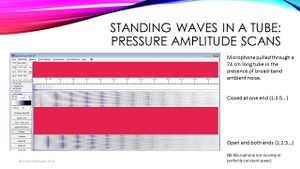Course:PHYS341/2018/Calendar/Lecture15
Appearance
Phys341 Lecture 15: Summary and web references
2018.02.05
Textbook 12.1-12.3
Slide List
- Some terminology
- For nearly all musical instruments, one of the most important factors is the contained air.
- This is true for a violin as for a flute.
- Air has pressure, density, velocity.
- For our purposes, pressure and density go hand-in-hand: if you compress air the density goes up (same mass, less volume).
- Acoustic pressure is the rapidly oscillating difference between measured air pressure (say, inside an instrument at a certain time and position), and ambient air pressure; acoustic pressure can be positive or negative.
- Acoustic pressure is measured with a microphone.
- Acoustic velocity is the rapidly oscillating velocity of the air; acoustic velocity can be positive or negative. It is hard to measure directly.
- Acoustic velocity is NOT the random velocity of individual air molecules, and it is NOT the speed of flow down a pipe (e.g. your breath exiting your mouth while talking, singing or whistling).
- Flow and standing wave can exist together https://www.youtube.com/watch?v=YnyM9SUipfE
- Normal modes in a pipe
- A “normal mode” is a standing wave in which all parts of the object are moving with one frequency.
- Strings tend to be held tightly between two fixed end-points (a loose end is musically useless).
- With air in a pipe there are more possibilities for the end points than with a string. The pipe ends can be open or closed.
- Closed pipe means the air velocity is fixed at zero (the air is up against a hard boundary).
- Open pipe means the acoustic pressure is fixed at zero* (contact with free air).
- Three (extreme) possibilities: closed-closed, closed-open, open-open.
- The shapes of the modes are very similar to those seen on strings.
*Not quite true; see later
- Normal modes of a string
- Here are the first three normal modes of a string held tightly at both ends.
- Mode 2 vibrates at twice the frequency of mode 1; i.e. an octave higher.
- Mode 3 vibrates at three times the frequency of mode 1, i.e. an octave and a fifth higher.
- Here, y is the transverse displacement of the string.
- Normal modes in a pipe
- Here are the first three normal modes of a pipe closed at both ends.
- The shapes look the same as those for standing waves on a string.
- Here, v is longitudinal acoustic velocity of the air, pinned at zero by the ends.
- The mode frequencies are still in ratio 1:2:3...
- Note the tiny amplitude of the velocity, ~ 0.2 mm/s
- (for a pressure amplitude of 1 Pa which corresponds to a SPL of 91 dB – loud!)
- Normal modes in a pipe I
- Here are the first three normal modes of a pipe closed at both ends.
- Imagine the dots to be air molecules, jiggled with random thermal motion, and also moving with the acoustic wave.
- Let your eye distinguish the jiggling from the larger collective motion.
- The size of the displacement is hugely exaggerated, or you would not see it.
- Normal modes in a pipe II
- Here we look at the acoustic pressure in the pipe (closed at both ends).
- The shapes are in some sense opposite to the velocity shapes:
- nodes in velocity → antinodes in pressure
- antinodes in velocity → nodes in pressure
- As the air hits the end walls, the pressure varies maximally, while the longitudinal velocity is constrained the be zero (the air cannot go through the walls).
- A different view – pressure contours
- Open one end of the pipe
- A pipe closed at both end is musically useless, so open one end – like a resonator on a marimba.
- Here we look at velocity:
- Zero at the wall (left)
- Maximal at the open end (right)
- Open one end of the pipe
- Pipe open at one end
- But...
- With an open end, sound is radiated to the environment: we have the makings of a musical instrument.
- Simulation:
- Pipe closed at bottom
- 3rd mode
- Radiated wave greatly exaggerated for visibility
- Note: if we could place our ears inside a flute, we would be deafened.
- Pipe open at both ends
- A pipe open at both ends has the same spectrum of modes as a pipe closed at both ends.
- Differences:
- Ends are pressure nodes (open to the environment)
- Ends are velocity (and displacement) antinodes
- Radiates from both ends
- Looking ahead, instruments with air reeds (recorders, organ pipe, xiaos etc.) behave approximately like pipes with two open ends.
- Pipe summary
- Pipes open at both ends have a spectrum of modes 1:2:3...
- For a length of 1m: 172 Hz, 344 Hz, 516 Hz... (F3, F4, C5...)
- For a length of 0.5m, an octave higher (twice the frequency).
- Pipes open at one end have a spectrum of modes 1:3:5...
- For a length of 1m: 88 Hz, 264 Hz, 440 Hz... (F2, C4, A4...)
- For a length of 0.5m, an octave higher (twice the frequency).
- Standing waves in a tube: Pressure amplitude scans

Microphone scan of 74 cm tube
